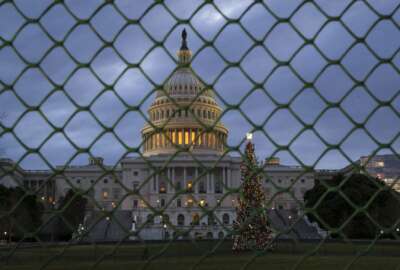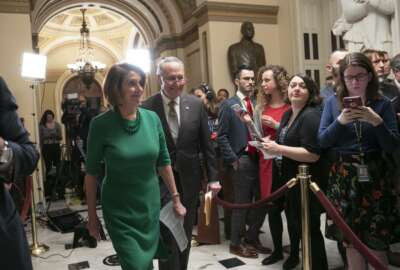
Government shutdowns: Once ‘incomprehensible, inconceivable, unthinkable,’ now the norm
Government shutdowns are the norm today, but it wasn't always that way. A 1980 interpretation of the Antideficiency Act changed the way both the executive and...
Forty years ago, there was no such thing as a government shutdown.
When appropriations lapsed, agencies halted new business but continued with their existing responsibilities, confident that Congress would eventually fund them. Depending on the length of the shutdown, federal employees might have gotten paid late, and GI Bill checks and housing subsidies may have been delayed. But most business continued.
That all changed in 1980, when the then-attorney general revisited a 100-year-old law and decided agencies should take lapses in appropriations far more seriously.
So what happened?
Successor administrations took that opinion so seriously that they have shut down the government at least 10 times since. The impact from each one has varied, but the shutdowns have cost taxpayers billions of dollars and prompted financial uncertainty and hardship for hundreds of thousands of federal employees working or furloughed without pay.
Federal employees have experienced three shutdowns in 2018 alone, and at 23 days and counting, the current partial lapse in appropriations is the longest ever.
A March 1981 report from the Government Accountability Office, then known as the General Accounting Office, describes — at times with tragic irony — how “incomprehensible, inconceivable and unthinkable” a government shutdown would be to federal agencies and their employees. The report also included several options Congress could take to ensure a genuine shutdown would never occur.
But now, due to congressional inaction, a nearly 40-year-old legal interpretation and years of precedent, they’re the norm.
The Antideficiency Act
In 1980, the federal government was looking at another lapse in appropriations at the beginning of fiscal 1981. In the buildup to this expected funding gap, President Jimmy Carter asked then-Attorney General Benjamin Civiletti to look into whether a law passed in 1884 permitted federal employees to work without appropriations.
That law was the Antideficiency Act, originally passed to prevent federal agencies from spending more money than Congress appropriated, and imposing criminal penalties on any federal employee, officer or executive who violated this.
Civiletti determined that any federal agencies that continued operations and incurred obligations after appropriations lapsed, including paying employees, would be in violation of the Antideficiency Act, and that the Department of Justice would be obligated to prosecute.
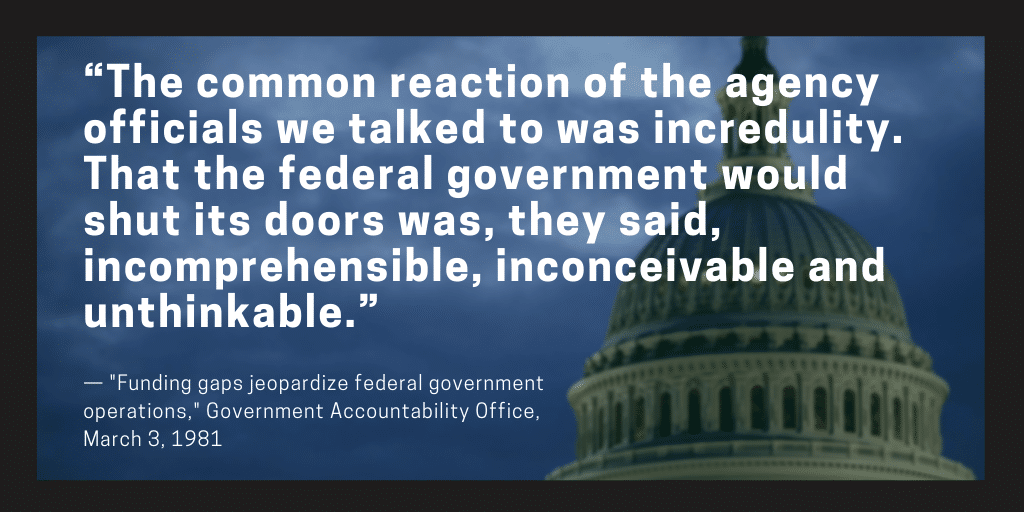
This overruled decades of precedent. Before 1980, it was generally assumed that Congress’ failure to pass appropriations on time did not indicate that it had intended agencies to cease operations. This assumption was supported by the fact that Congress usually included language in continuing resolutions that retroactively covered obligations incurred during funding lapses.
It was this confidence in Congress’ intent that had allowed agencies to continue business in spite of the Antideficiency Act. Even GAO agreed with this assessment when asked by Congress.
“We do not believe that the Congress intends the federal agencies be closed during periods of expired appropriations,” said then-Comptroller General Elmer Staats.
But with the new opinion from the attorney general, all that changed.
Planning for the first shutdown
“Never before had heads of agencies been required to seriously plan the tasks and identify the staff that would be needed to begin closing down an agency’s activities,” the report said. “Faced with a drastic change in the status quo, federal officials felt compelled to take action to indicate compliance with the Act, or at least to avoid giving the appearance that they were in violation of it.”
The problem was that nobody knew what action to take. The Office of Management and Budget didn’t issue guidance until the end of August 1980, a little more than a month before funding would run out. But that guidance was seen by some agency officials as contradictory and confusing, and some agencies even disregarded parts of it that didn’t fit their draft plans. Further muddying the issue, OMB and Justice did not answer questions agency officials submitted for clarification.
GAO interviewed 18 agencies after the fact about their shutdown plans. Of those, 13 made plans of varying degree of detail. Some plans specified essential functions, personnel, how to shut down and how long it would take. The other five were less detailed, some intending to begin planning on the first day of lapsed appropriations.
In fact, the departments of Defense and State both assumed that appropriations would be passed on time, and if not, the activities of their departments would continue as normal due to national security considerations.
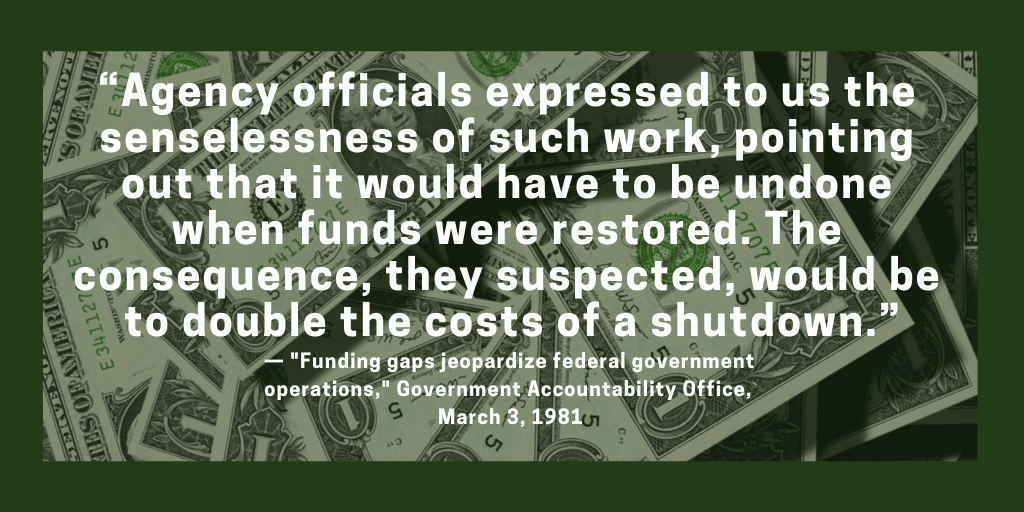
GAO’s report points to a general atmosphere of disbelief among officials that contributed to the lack of preparation.
“All officials we interviewed told us that their agency’s plans were not final or official because they had not been reviewed or approved by top managers,” the report said. “When we asked about the status of the planning process, several officials said that while plans were well underway in late September, they were in no hurry to complete them because they hoped that an appropriations gap would not occur.”
The report also mentions that officials may have delayed because “if the plans had been deemed official, agency heads might have been expected to implement them.”
In the end, Congress passed a continuing resolution and Carter signed it on Oct. 1, 1980, avoiding what almost became the first government shutdown. Technically, appropriations lapsed for 16 hours, but GAO said it couldn’t find any agencies that conducted business in any way outside the norm.
Have shutdowns changed?
Much has changed in the way of government shutdowns since 1980.
Today, each agency maintains and updates a shutdown contingency plan, which OMB publishes on its website. There are now general procedures that agencies follow for determining which employees are “excepted” or “non-excepted” and for communicating those determinations to their workforces.
The concept of a government shutdown as we know it today stemmed from the approach that the Clinton administration took during the 1995-1996 lapse in appropriations, said Frank Reeder, who served at OMB in various roles from 1970-1990.
“Shutdowns hadn’t been taken seriously in the sense that anybody tried to, if you will, make them ‘hard’ shutdowns — that is, enforce the letter of the Civiletti opinion. Agencies tended to take a very liberal view of persons who could be exempted from the shutdown,” Reeder said. “Shutdowns tended to be a fairly ‘soft’ event, fairly brief. In [1995], the Clinton administration made a decision that we were going to enforce the letter of the Civiletti opinion.”
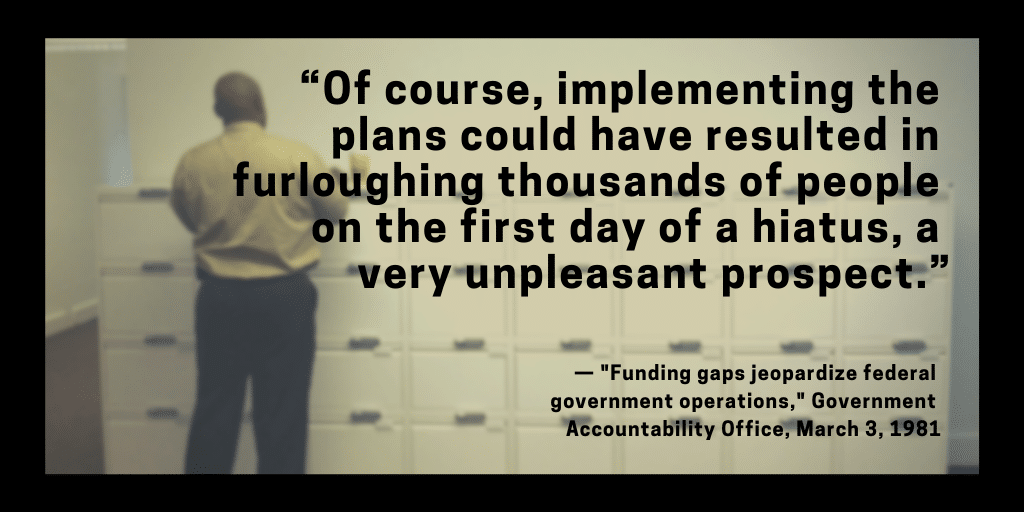 Strict compliance with the 1980 Antideficiency Act interpretation was the “order of the day,” Reeder said, and OMB became the “strict enforcer.” John Koskinen, then OMB’s deputy director for management, became anecdotally known as the “shutdown czar.”
Strict compliance with the 1980 Antideficiency Act interpretation was the “order of the day,” Reeder said, and OMB became the “strict enforcer.” John Koskinen, then OMB’s deputy director for management, became anecdotally known as the “shutdown czar.”
The Obama and Trump administrations since have followed a similar mentality: Only those employees and activities deemed “essential” by their agencies to protect life and property would continue to work. Everyone else would go home and wait for Congress and the White House to reach a compromise on a spending deal.
Does it have to be this way?
But perhaps this exercise of shutting down agencies, furloughing some and requiring others to work without pay is simply that — a political exercise that’s open to judgment and analysis.
After all, the Civiletti opinion of the Antideficiency Act is an interpretation. Perhaps there’s more room for more judgement and analysis — or at least a more liberal view of what has since become precedent since the 1980 decision.
More Government Shutdown News:
“My marching orders from [OMB acting Director] Russ Vought and Mick Mulvaney, [White House chief of staff] and up to the President was, make this as painless as possible, consistent with the law,” a senior administration official said in an interview last week with Federal News Network. “There is the law, and there are longstanding exceptions to the law. There are judgment calls with those exceptions. We spent a lot of time on it with the agency’s counsel, with OMB lawyers, with Department of Justice lawyers, to make sure that — with our marching orders to make this as painless as possible — we are being consistent with the law.”
The IRS’ decision to pay tax refunds and the Agriculture Department’s decision to issue supplemental nutrition benefits are examples of the administration’s approach.
And the Trump administration — as well as the Obama and Clinton administrations that came before it — is trying to balance and win a political argument. On one hand, administrations want to take the lapse in appropriations seriously, but on the other, they don’t want to inflict political damage on themselves, Reeder said.
“A strict interpretation of the Civiletti opinion would say you don’t need any IRS people on board, period, except perhaps to make sure that the doors are locked,” Reeder said. “At the same time, the backlash if we get much further down the road and [with] folks who are expecting tax refunds will be huge. We’re in what is largely a political game.”
GAO’s ideas
Interpretations aside, GAO has also suggested a number of ways Congress could avoid future government shutdowns altogether.
For example, Congress could permanently authorize agencies to incur obligations for continued operations. This was the suggestion that earned GAO’s endorsement. The idea is that agencies would continue to function during a lapse in appropriations, but would still be unable to issue payments. The obligations incurred during the lapse would be paid for when appropriations are enacted.
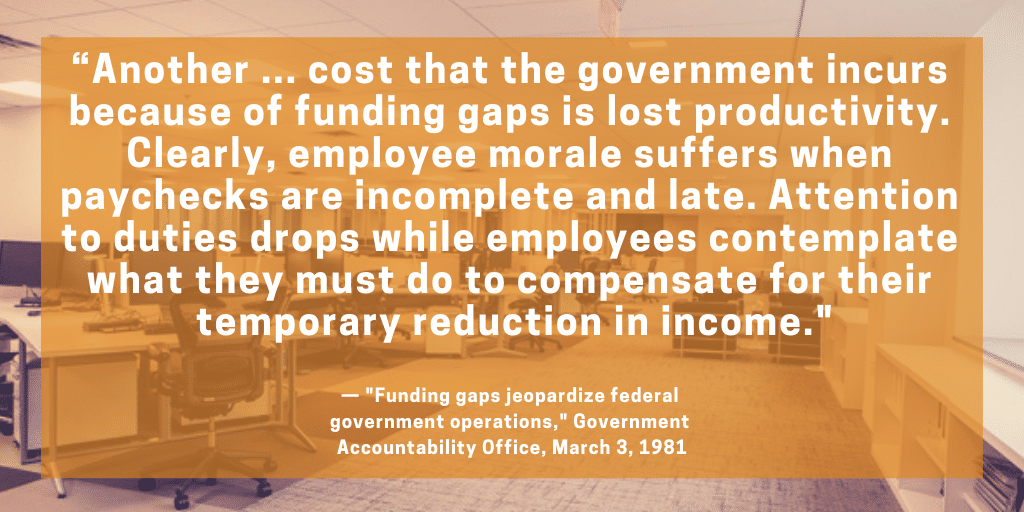
This would alleviate the need to shut down agencies’ operations, or even create shutdown plans. It would essentially codify the pre-1980 assumption that, despite the lapse in appropriations, Congress could not have intended the government to actually shut down. And it works within the Antideficiency Act, which allows for obligations “authorized by law.”
This also ticks all the boxes of GAO’s criteria for a good shutdown plan. It’s long-term, and would automatically apply during a funding gap. Congress keeps control of appropriations, as agencies can’t actually pay out any money unless Congress appropriates it. It covers all agencies, and all activities. And it’s politically neutral, favoring no party or ideology.
There are downsides to this idea, however. If agencies can incur obligations but aren’t allowed to distribute any funds, that means federal employees don’t get paid until the appropriations pass. It also means contractors don’t get paid and benefits like GI Bill payments won’t get disbursed.
It’s worth noting that at the time of the report, GAO actually listed this as an advantage, assuming pressure from these groups would incentivize Congress to curtail politically-sensitive debate and compromise on legislation.
Related Stories
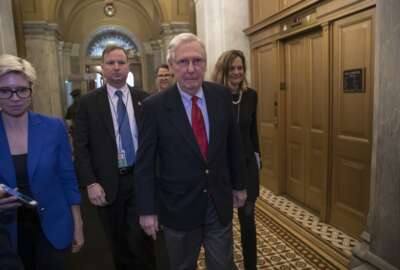
Partial government shutdown begins after Congress, White House fail to reach spending deal
GAO also suggested that Congress could amend the Antideficiency Act itself to allow agencies to incur obligations. This would essentially have the same effect as the first suggestion, and also allows some flexibility for agencies to potentially pay off those obligations during the funding gap, up to a certain specified level.
But GAO warned that tampering with the act could weaken what is the fundamental statute that prevents agencies from spending money they don’t have. GAO said it has stood the test of time, and since working within the statute is just as easy as amending it, the office recommended against this avenue.
A permanent continuing resolution, which would automatically take effect when appropriations lapse and set limits to the average level of expenditures for the previous year could also accomplish these goals, though this would also have to provide for retroactive payments of any expenditures not authorized in the previous fiscal year.
Noting that, at the time, riders — usually politically volatile add-ons — were the main cause of lapsed appropriations, GAO said that Congress could limit or forbid riders on appropriations bills, or require a two-thirds vote to include them. The idea is that this would limit ideological debates from holding up appropriations, and reduce the number of funding gaps.
But GAO said Congress would likely resist this measure, which would not apply to every funding lapse, and would not be politically neutral.
GAO also considered several bills in the 96th Congress that would have permanently provided pay for government employees, both civilian and military, during lapsed appropriations. Most of them lacked comprehensiveness, GAO said, and the one bill that provided permanent authority to continue salaries deprives Congress of short-term control over appropriations. However, Congress could place ceilings on these appropriations, GAO said, in order to maintain long-term control.
Congress has in recent years attempted to debate and consider some of these ideas.
Sen. Rand Paul (R-Ky.) has advocated for automatic continuing resolutions and introduced the Government Shutdown Prevention Act in the previous Congress.
Paul’s bill went nowhere in the Senate, but other senators have picked up on the concept as the current partial shutdown extends past three weeks.
Sen. Rob Portman (R-Ohio) has introduced the End Government Shutdowns Act, a bill that would also provide for automatic continuing resolutions. It has eight Republican co-sponsors.
The Joint Select Committee on Budget and Appropriations Process Reform, which Congress formed as part of the Bipartisan Budget Act of 2018, was supposed to draft legislative language that would “significantly reform the budget and appropriations process.” Committee members again suggested the concept of implementing automatic continuing resolutions or requiring that lawmakers stay in Washington until spending bills had been finalized and voted out of Congress.
But committee members couldn’t agree and ultimately settled on recommendations that simply reiterate existing congressional practices, such as drafting budget resolutions two years at a time.
And perhaps ironically, congressional leadership said Capitol Hill wouldn’t have time to consider the select committee’s budget reform recommendations in the 115th Congress. The House and Senate had too much appropriations work to finish before funding ran dry at the end of 2018, congressional leaders said.
So the committee’s recommendations went nowhere.
Copyright © 2025 Federal News Network. All rights reserved. This website is not intended for users located within the European Economic Area.
Nicole Ogrysko is a reporter for Federal News Network focusing on the federal workforce and federal pay and benefits.
Follow @nogryskoWFED
Daisy Thornton is Federal News Network’s digital managing editor. In addition to her editing responsibilities, she covers federal management, workforce and technology issues. She is also the commentary editor; email her your letters to the editor and pitches for contributed bylines.
Follow @dthorntonWFED

